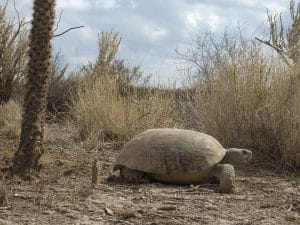Gopherus evgoodei (Sinaloan thornscrub tortoise)
Home > Turtle Database > Gopherus evgoodei (Sinaloan thornscrub tortoise)

The Gopherus evgoodei, or Sinaloan thornscrub tortoise, is a unique tortoise species found in the thornscrub ecosystems of Sinaloa, Mexico. This tortoise is known for its ability to survive in hot, arid environments with limited water resources, showing fascinating adaptations that help it thrive in such harsh landscapes.
Native Turtle Species Map – Find Turtles by Region
Scientific Classification
- Kingdom: Animalia
- Phylum: Chordata
- Class: Reptilia
- Order: Testudines
- Family: Testudinidae
- Genus: Gopherus
- Species: Gopherus evgoodei
Common Names
- Sinaloan thornscrub tortoise
- Sinaloan desert tortoise
- Goode’s desert tortoise
This Hilarious Turtle Book Might Know Your Pet Better Than You Do
Let’s be real—most turtle care guides feel like reading a textbook written by a sleep-deprived zookeeper.
This one’s not that.
Told from the snarky point of view of a grumpy, judgmental turtle, 21 Turtle Truths You’ll Never Read in a Care Guide is packed with sarcasm, sass, and surprisingly useful insights.
And hey—you don’t have to commit to the whole thing just yet.
Grab 2 free truths from the ebook and get a taste of what your turtle really thinks about your setup, your food choices, and that weird plastic palm tree.
It’s funny, it’s honest, and if you’ve ever owned a turtle who glares at you like you’re the problem—you’ll feel seen.
Identification
Description
The Sinaloan thornscrub tortoise has a domed shell with a rough, textured surface, typically in shades of brown or tan that help it blend into its scrubland environment. The shell is sturdy and provides protection from predators and harsh conditions.
Sexual Dimorphism
Males are generally larger with a more concave plastron (underside of the shell) and have a longer tail than females. Males also possess slightly thicker forelimbs and a distinct notch at the rear of the shell, which females lack.
Check more turtles from the Gopherus genus
Native Origin and Distribution
Geographical Range
This species is native to the thornscrub regions of southern Sinaloa, Mexico, where it inhabits dry, rocky areas that provide both shelter and access to sparse vegetation.
Preferred Habitat
The Sinaloan thornscrub tortoise favors arid thornscrub landscapes, often characterized by sparse vegetation, thorny bushes, and rocky outcrops. This habitat offers shade and protection while providing a limited but suitable food supply.
Behavior
Feeding Habits
This tortoise is herbivorous, feeding on a diet of grasses, cacti, and other desert vegetation. It has adapted to store water and relies on succulent plants to meet its hydration needs.
Predators
The tortoise’s main predators include coyotes, birds of prey, and humans, who may hunt it or disturb its habitat.
Reproduction
Breeding Season
The breeding season for the Sinaloan thornscrub tortoise typically occurs in late spring and early summer when food resources are more abundant.
Reproductive Method
The tortoise is oviparous, laying a small clutch of eggs in shallow burrows. These eggs hatch after a few months, with hatchlings emerging during the rainy season when food and water are more accessible.
Conservation
Extinction Status
The Gopherus evgoodei is classified as vulnerable due to habitat loss and fragmentation.
Threats
Habitat destruction from agriculture and urban expansion poses the largest threat to this species. Illegal collection for the pet trade further reduces wild populations.
Conservation Measures
Conservation efforts include habitat protection, research, and raising public awareness about the threats facing this tortoise. Mexico has also implemented regulations to restrict collection and trade.
Economic Importance
Though not a species with significant direct economic value, this tortoise is essential for maintaining ecosystem balance by aiding in plant dispersal through its diet, which benefits the thornscrub biome.
Interesting Facts
- The Sinaloan thornscrub tortoise can survive for long periods without direct water, relying on moisture-rich plants.
- They dig shallow burrows to escape extreme temperatures, particularly during the hottest months.
- Unlike many tortoise species, these tortoises may spend most of their time hidden in burrows or shaded areas due to the intensity of their environment’s sun.

About Author
Muntaseer Rahman started keeping pet turtles back in 2013. He also owns the largest Turtle & Tortoise Facebook community in Bangladesh. These days he is mostly active on Facebook.














